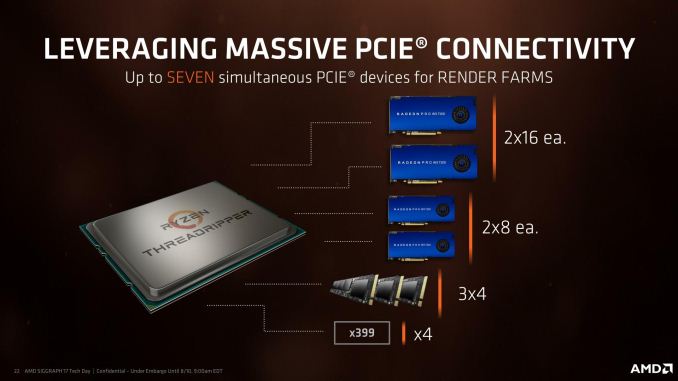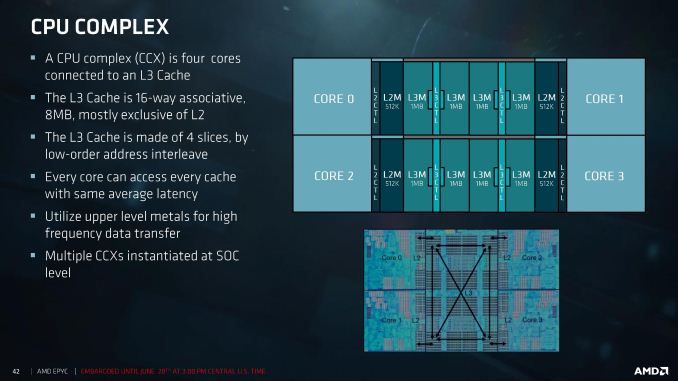The AMD Ryzen Threadripper 1950X and 1920X Review: CPUs on Steroids
by Ian Cutress on August 10, 2017 9:00 AM ESTFeeding the Beast
When frequency was all that mattered for CPUs, the main problem became efficiency, thermal performance, and yields: the higher the frequency was pushed, the more voltage needed, the further outside the peak efficiency window the CPU was, and the more power it consumed per unit work. For the CPU that was to sit at the top of the product stack as the performance halo part, it didn’t particularly matter – until the chip hit 90C+ on a regular basis.
Now with the Core Wars, the challenges are different. When there was only one core, making data available to that core through caches and DRAM was a relatively easy task. With 6, 8, 10, 12 and 16 cores, a major bottleneck suddenly becomes the ability to make sure each core has enough data to work continuously, rather than waiting at idle for data to get through. This is not an easy task: each processor now needs a fast way of communicating to each other core, and to the main memory. This is known within the industry as feeding the beast.
Top Trumps: 60 PCIe Lanes vs 44 PCIe lanes
After playing the underdog for so long, AMD has been pushing the specifications of its new processors as one of the big selling points (among others). Whereas Ryzen 7 only had 16 PCIe lanes, competing in part against CPUs from Intel that had 28/44 PCIe lanes, Threadripper will have access to 60 lanes for PCIe add-in cards. In some places this might be referred to as 64 lanes, however four of those lanes are reserved for the X399 chipset. At $799 and $999, this competes against the 44 PCIe lanes on Intel’s Core i9-7900X at $999.
The goal of having so many PCIe lanes is to support the sort of market these processors are addressing: high-performance prosumers. These are users that run multiple GPUs, multiple PCIe storage devices, need high-end networking, high-end storage, and as many other features as you can fit through PCIe. The end result is that we are likely to see motherboards earmark 32 or 48 of these lanes for PCIe slots (x16/x16, x8/x8/x8/x8, x16/x16/x16, x16/x8/x16/x8), followed by a two or three for PCIe 3.0 x4 storage via U.2 drives or M.2 drives, then faster Ethernet (5 Gbit, 10 Gbit). AMD allows each of the PCIe root complexes on the CPU, which are x16 each, to be bifurcated down to x1 as needed, for a maximum of 7 devices. The 4 PCIe lanes going to the chipset will also support several PCIe 3.0 and PCIe 2.0 lanes for SATA or USB controllers.
Intel’s strategy is different, allowing 44 lanes into x16/x16/x8 (40 lanes) or x16/x8/x16/x8 (40 lanes) or x16/x16 to x8/x8/x8x8 (32 lanes) with 4-12 lanes left over for PCIe storage or faster Ethernet controllers or Thunderbolt 3. The Skylake-X chipset then has an additional 24 PCIe lanes for SATA controllers, gigabit Ethernet controllers, SATA controllers and USB controllers.
Top Trumps: DRAM and ECC
One of Intel’s common product segmentations is that if a customer wants a high core count processor with ECC memory, they have to buy a Xeon. Typically Xeons will support a fixed memory speed depending on the number of channels populated (1 DIMM per channel at DDR4-2666, 2 DIMMs per channel at DDR4-2400), as well as ECC and RDIMM technologies. However, the consumer HEDT platforms for Broadwell-E and Skylake-X will not support these and use UDIMM Non-ECC only.
AMD is supporting ECC on their Threadripper processors, giving customers sixteen cores with ECC. However, these have to be UDIMMs only, but do support DRAM overclocking in order to boost the speed of the internal Infinity Fabric. AMD has officially stated that the Threadripper CPUs can support up to 1 TB of DRAM, although on close inspection it requires 128GB UDIMMs, which max out at 16GB currently. Intel currently lists a 128GB limit for Skylake-X, based on 16GB UDIMMs.
Both processors run quad-channel memory at DDR4-2666 (1DPC) and DDR4-2400 (2DPC).
Top Trumps: Cache
Both AMD and Intel use private L2 caches for each core, then have a victim L3 cache before leading to main memory. A victim cache is a cache that obtains data when it is evicted from the cache underneath it, and cannot pre-fetch data. But the size of those caches and how AMD/Intel has the cores interact with them is different.
AMD uses 512 KB of L2 cache per core, leading to an 8 MB of L3 victim cache per core complex of four cores. In a 16-core Threadripper, there are four core complexes, leading to a total of 32 MB of L3 cache, however each core can only access the data found in its local L3. In order to access the L3 of a different complex, this requires additional time and snooping. As a result there can be different latencies based on where the data is in other L3 caches compared to a local cache.
Intel’s Skylake-X uses 1MB of L2 cache per core, leading to a higher hit-rate in the L2, and uses 1.375MB of L3 victim cache per core. This L3 cache has associated tags and the mesh topology used to communicate between the cores means that like AMD there is still time and latency associated with snooping other caches, however the latency is somewhat homogenized by the design. Nonetheless, this is different to the Broadwell-E cache structure, that had 256 KB of L2 and 2.5 MB of L3 per core, both inclusive caches.












347 Comments
View All Comments
sorten - Friday, August 11, 2017 - link
Swole? Threadripped?Rottie - Friday, August 11, 2017 - link
AMD Ryzen CPU is not fast enough. Apple is not ready for AMD Ryzen CPU, sorry AMD. I love AMD but I hated Intel even though I have a Skylake based MacBook Pro. :(Deshi! - Friday, August 11, 2017 - link
One small correction, Ryzen has 24 PCIE lanes, not 16. it has 16 for graphics only, but saying only 16 may make people (like me) wonder if you can't run an NVME at x4 and still have the graphics card at 16x, which you totally can do.Deshi! - Friday, August 11, 2017 - link
This is under Feeding the beast section btw, where you said "Whereas Ryzen 7 only had 16 PCIe lanes, competing in part against CPUs from Intel that had 28/44 PCIe lanes,"fanofanand - Tuesday, August 15, 2017 - link
He already answered this question/statement to someone else. there are 20 lanes from the CPU, 16 of which are available for graphics. I don't think his way of viewing it seems accurate, but he has stated that this is how PCIe lanes have been counted "for decades"WaltC - Friday, August 11, 2017 - link
Nice review, btw! Yes, going all the way back to Athlon and the triumph of DDR-Sdram over Rdram, and the triumph of AMD's x86-64 over Itanium (Itanium having been Intel's only "answer" for 64-bit desktop computing post the A64 launch--other than to have actually paid for and *run* an Intel ad campaign stating "You don't need 64-bits on the desktop", believe it or not), and going all the way back to Intel's initial Core 2 designs, the products that *actually licensed x86-64 from AMD* (so that Intel could compete in the 64-bit desktop space it claimed didn't exist), it's really remarkable how much AMD has done to enervate and energize the x86 computing marketplace globally. Interestingly enough it's been AMD, not Intel, that has charted the course for desktop computing globally--and it goes all the way back to the original AMD Athlon. The original Pentium designs--I owned 90MHz and 100MHz Pentiums before I moved to AMD in 1999--were the high-point of an architecture that Intel would *cancel* shortly thereafter simply because it could not compete with the Athlon and its spin-off architectures like the A64. That which is called "Pentium" today is not...;) Intel simply has continued to use the brand. All I can say is: TGF AMD...;) I've tried to imagine where Intel would have taken the desktop computing market had consumers allowed the company to lead them around by the nose, and I can't...;) If not for AMD *right now* and all the activity the company is bringing to the PC space once again, there would not be much of a PC market globally going on. But now that we have some *action* again and Intel is breaking its legs trying to keep up, the PC market is poised to break out of the doldrums! I guess Intel had decided to simply nap for a few decades--"Wake me when some other company does something we'll have to compete with!" Ugh.zeroidea - Friday, August 11, 2017 - link
Hi Ian,On the Civ 6 benchmark page, all results after the GTX 1080 are mislabeled as GTA 6.
Ahmad Rady - Friday, August 11, 2017 - link
Can you try to test this CPU using windows server?This is a MCM CPU looks like 4 CPUs attached to each other.
I think windows 10 Pro can't get the most of this CPU unless we have windows 10 Pro for WS
Pekish79 - Friday, August 11, 2017 - link
Vray has a Rendering Benchmark too maybe you could use bothPekish79 - Friday, August 11, 2017 - link
I went to check both page of Vray and Corona BenchmarkCorona match more or less the graphic and Vray has the following
AMD 1950 : 00:46-00:48 sec
I9 7900: 00:54-00:56 sec
I7 6950: 01:00-01:10 sec
I5 5960: 01:23-01:33 sec